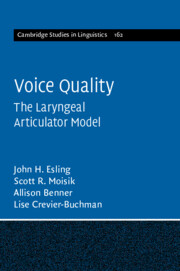Book contents
- Voice Quality
- Series page
- Cambridge Studies in Linguistics
- Voice Quality
- Copyright page
- Contents
- Figures
- Tables
- Preface
- Acknowledgements
- Abbreviations
- 1 Voice and Voice Quality
- 2 Laryngeal Voice Quality Classification
- 3 Instrumental Case Studies and Computational Simulations of Voice Quality
- 4 Linguistic, Paralinguistic, and Extralinguistic Illustrations of Voice Quality
- 5 Phonological Implications of Voice Quality Theory
- 6 Infant Acquisition of Speech and Voice Quality
- 7 Clinical Illustrations of Voice Quality
- 8 Laryngeal Articulation and Voice Quality in Sound Change, Language Ontogeny and Phylogeny
- References
- Author/Artist Index
- Subject Index
7 - Clinical Illustrations of Voice Quality
Published online by Cambridge University Press: 21 June 2019
- Voice Quality
- Series page
- Cambridge Studies in Linguistics
- Voice Quality
- Copyright page
- Contents
- Figures
- Tables
- Preface
- Acknowledgements
- Abbreviations
- 1 Voice and Voice Quality
- 2 Laryngeal Voice Quality Classification
- 3 Instrumental Case Studies and Computational Simulations of Voice Quality
- 4 Linguistic, Paralinguistic, and Extralinguistic Illustrations of Voice Quality
- 5 Phonological Implications of Voice Quality Theory
- 6 Infant Acquisition of Speech and Voice Quality
- 7 Clinical Illustrations of Voice Quality
- 8 Laryngeal Articulation and Voice Quality in Sound Change, Language Ontogeny and Phylogeny
- References
- Author/Artist Index
- Subject Index
Summary
Chapter 7 explores laryngeal speech disorders, voice pathologies that depart from normal function, and the consequences of laryngeal surgery on voice quality from the perspective of the Laryngeal Articulator Model. Clinical cases involve the laryngeal mechanism as a whole, and many voice quality outcomes resemble the registers of linguistic systems. New drawings diagram surgical excisions of laryngeal structures. Post-surgery compensatory behaviours demonstrate innovative adaptation of the aryepiglottic sphincter mechanism to generate ‘substitution voice’. Numerous videos/audio of clinical cases illustrate the effect of pathologies on voice quality. Pre- and post-operative speech production show how altered structures create altered voice quality. Epilaryngeal tube control is shown to be the cornerstone of our ability to adapt. Mongolian long song and human beatboxing illustrate the use of the professional voice. Clinicians as well as linguists will benefit from the detailed new exploration of the laryngeal articulator and its adaptability.
Keywords
- Type
- Chapter
- Information
- Voice QualityThe Laryngeal Articulator Model, pp. 205 - 238Publisher: Cambridge University PressPrint publication year: 2019



